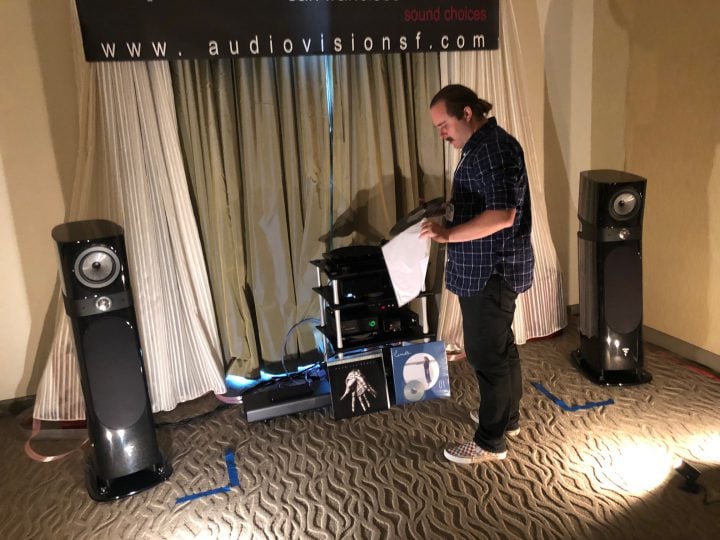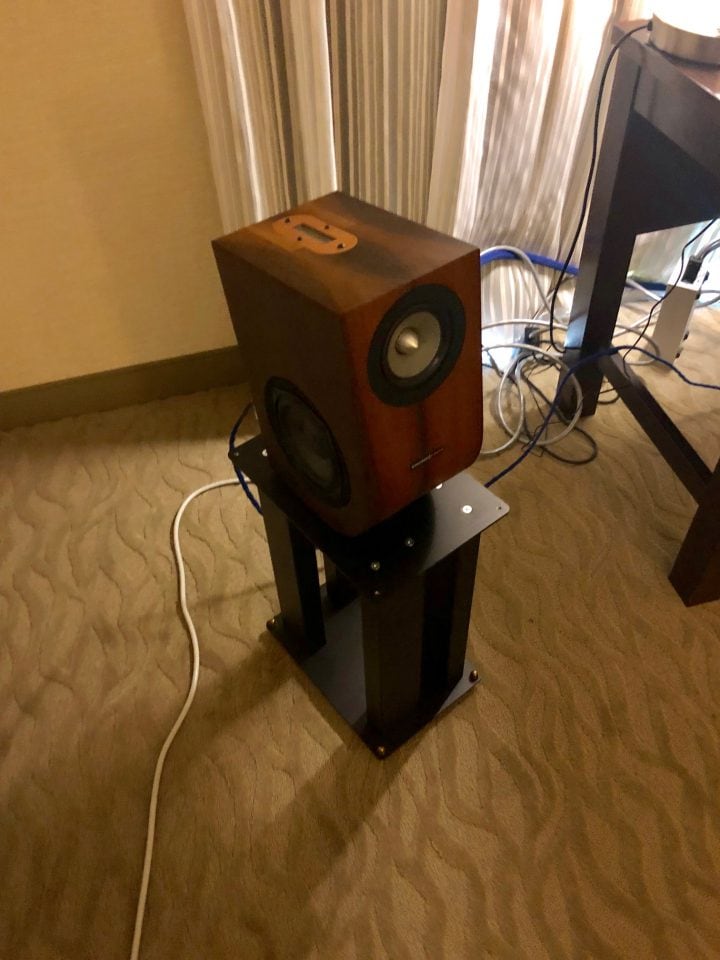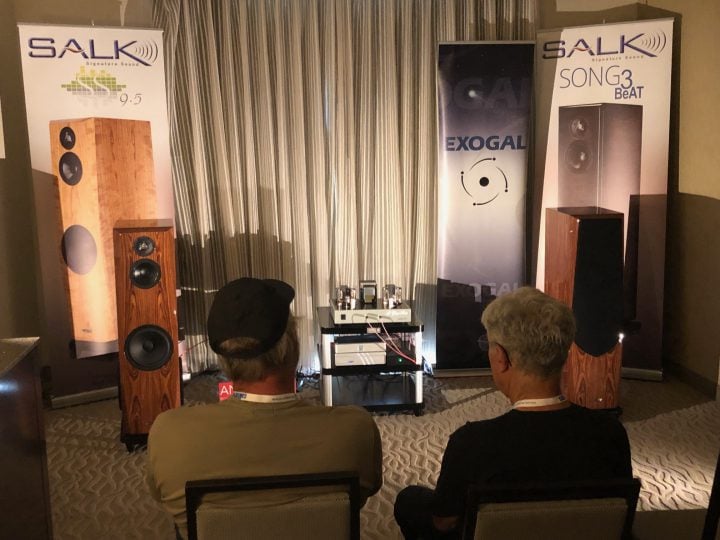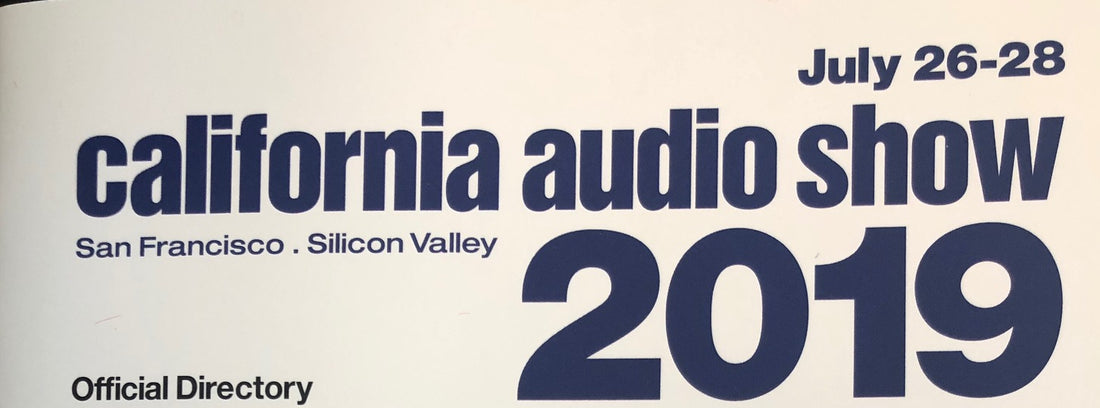Part 1 of my report on the California Audio Show appeared in Copper #91. That article gave an overview of the show, and described the exhibit rooms on the first floor. This concluding piece will go through the remaining rooms of the show, located on the second floor of Building V at the Hilton Oakland Airport.
Here’s how the rooms were laid out:

One of the benefits of this show is that one can see and hear products that are rarely, if ever, present at other shows. Other than Ray Kimber’s giant demos at RMAF some years ago, I don’t recall ever encountering Sound Labs at a show.
Now, I am familiar with the big Sound Lab ‘stats, as a client had an enormous 3-floor system which utilized more Sound Lab speakers than could be found anywhere outside of the factory. The clarity and precision of the speakers was impressive, as was the impact of the bass—unusual for a ‘stat.
So: I was happy to see the Sound Labs demonstrated by dealer Ultimate Audio. Two things were quickly apparent to me: the speaker was far too large for the standard hotel room, and the edginess of the Bricasti electronics that I mentioned in Part 1—shall we say, cut through the morning fog from the Bay. I appreciate the effort, but this combo was not for me.

Also Sprach Zarathustra, anyone?
I’d previously mentioned that there were four rooms (I initially said three, but I can’t count) in which I would and did happily stay and just listen for pleasure. In Part 1 I mentioned the Marutani Consulting room with big MartinLogans, Doshi electronics, and tape playback. The second of the four rooms was the Zesto/Joseph audio room, in which the always-affable George and Carolyn Counnas from Zesto played records on a Merrill-Williams turntable through all-Zesto tube gear and the latest Joseph Audio Perspective2 Graphene speakers.
If there was anything missing from the sound, it may have been bombastic, THX-style bass. To me, that’s not a loss. This was a lifelike, sweet-sounding system, one I could easily live with.



Well, you can see one of the Joseph speakers here. Apparently, I was having too much fun—my photos are even worse than usual. Mea culpa.
Next up was the room of local dealer Audio Vision SF, a company I know and respect. The Focal/Naim/Rega/etc. system was pleasant and dynamic, but lacked a little grit, for my taste. Many would find that a good thing. The sound was excellent— just wasn’t quite my cuppa. Different strokes, YMMV, and so on.

 The Marchand/Bernhagen-Porter room was interesting for both the amps and the speakers. Marchand is well-known for electronic crossover kits, so it was a bit of a surprise to see an SET amp with a single 805 output tube and solid-state front end. The Bernhagen-Porter speakers were seen last year as well, the product of a partnership between a musician and a cabinet maker. The big speakers were beautifully made, and the built-in powered sub allowed the 20-watt Marchand amp to drive them to significant volume. The products from both these companies are certainly worth watching.
The Marchand/Bernhagen-Porter room was interesting for both the amps and the speakers. Marchand is well-known for electronic crossover kits, so it was a bit of a surprise to see an SET amp with a single 805 output tube and solid-state front end. The Bernhagen-Porter speakers were seen last year as well, the product of a partnership between a musician and a cabinet maker. The big speakers were beautifully made, and the built-in powered sub allowed the 20-watt Marchand amp to drive them to significant volume. The products from both these companies are certainly worth watching.

It was easy to anthropomorphize the four-legged Marchand amps.
For many years, David Cope gave superb demos for Audio Note. Now he runs an import company, Old Forge Audio, and his room was the third of my keepers. The system wasn’t huge or overwhelming, but every component was distinctive in design, and the overall sound was far bigger and more dynamic than you’d expect, given the small size of the speakers. The brands are likely not familiar to you yet, but I suspect that they will be.
I was smitten with the quirky looks and excellent build of all the products. The Wand turntable from New Zealand has a 14″ laminated platter and a carbon fiber arm; the Pure Audio electronics are also from NZ, and are Class A solid-state. The tiny but powerful SoundKaos Vox 3f Compact standmount speakers are from Switzerland, and pack a front-facing wideband driver, back-to-back side-mounted woofers, and a top-mounted RAAL ribbon tweeter into a small, curvilinear cabinet. Great stuff—but likely not for everyone. To me, that’s a plus.



The unusual SoundKaos speakers.
Exogal digital gear was featured in two rooms: one with a full set of Exogal electronics and Ryan speakers, the second with an Ion DAC feeding a tube amp from McGary Audio and Salk speakers. I was so busy blabbing with buddy Jeff Haagenstad of Exogal that I forgot to get pics of the Ryan room—and had to rely upon Jeff for those. Oops. Streaming Qobuz, the sound was well-defined and dynamic.


The Ryan R620s and their brethren have been seen and heard at many shows. They’re excellent.
The last of my four favorites was the Exogal/McGary/Salk room. The McGary tube amp brought to mind an updated Dynaco Stereo 70, and provided a little air and sweetening to the definition of the Exogal gear, and paired well with the full-range Salk speakers. The sound was involving and dynamic, and sucked in a lot of listeners besides me. I don’t think Jim Salk has ever made a bad speaker; the build quality is always impeccable, with lots of finish options, and the sound quality just keeps improving. The SS 9.5 speakers looked pretty conventional, but with dual passive radiators and an open-backed midrange, produced effortless bass and a huge soundstage. Very nice indeed.

 I half-jokingly said to Audio Note’s Peter Qvortrup, “You need to make some different-looking gear!” The reason for that is, well, if you stick your head into an AN exhibit room, you’ll be hit with a strong sense of deja vu. The gear probably changes from time to time, but it’s awfully hard to tell. Few brands produce strongly-held love/hate responses as Audio Note; this time, I found the sound pleasant, but not terribly involving.
I half-jokingly said to Audio Note’s Peter Qvortrup, “You need to make some different-looking gear!” The reason for that is, well, if you stick your head into an AN exhibit room, you’ll be hit with a strong sense of deja vu. The gear probably changes from time to time, but it’s awfully hard to tell. Few brands produce strongly-held love/hate responses as Audio Note; this time, I found the sound pleasant, but not terribly involving. 

Peter Qvortrup—so far this year I’ve run into him in Tampa, Munich, and now, Oakland. Axpona? I forget.
The last room of the show was that of Voxativ. Known for fullrange drivers, field-coils, rear-loaded horns, and other retro-nuevo tech, this year Holger Adler showed something curiously…modern.
But with a Voxativ twist.
The Hagen system shown consisted of a small, standmounted single driver speaker—very Voxativ. The twist was “Das Absolut Box”, a small component that provided lossless streaming, amplification, a DAC, and custom DSP for the speaker. Add a phone or computer and Qobuz, and you’re good to go. Cost for the system, minus stands? $7,900. In this world, that’s pretty cheap.
The sound wasn’t as big or as effortless as the bigger Voxativ speakers, but I give them full props for trying something new, and likely to reach a broader audience.


The Voxativ Hagens mit Das Absolut Box.
The life of an audio show organizer isn’t an easy one. Every show I’ve ever attended has been the target of complaints from exhibitors or attendees. At Axpona, some complained the show was too big; at CAS, some complained that the show was too small.
At 20 rooms, CAS ain’t huge. But the variety of exhibitors, allied with the ability to actually spend time talking with them in a relaxed, congenial atmosphere, sets CAS apart from other shows. Add in proximity to some Bay area delights, a pleasant venue, great weather—and I look forward to the 2020 show.
 After-show antics: Knucklehead brothers from different mothers non-exhibitor Gordon Burwell (Burwell & Son speakers) and exhibitor Jeff Haagenstad (Exogal) on a chilly night in Alameda.
After-show antics: Knucklehead brothers from different mothers non-exhibitor Gordon Burwell (Burwell & Son speakers) and exhibitor Jeff Haagenstad (Exogal) on a chilly night in Alameda.




